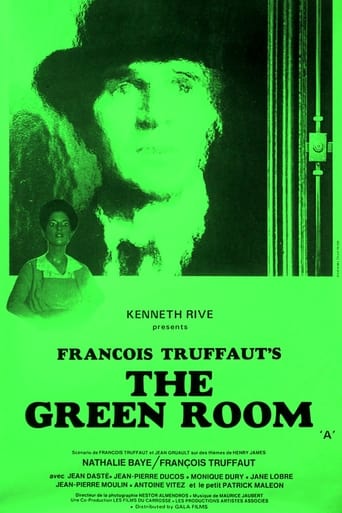wobelix
Most reviews here are positive, and luckily so: this is a tremendous film. Thought provoking, even disturbing a bit. And wonderfully photographed by Maestro Nestor Almendros. The film simply looks stupendous !What seems odd is that not one review here, against or for this film, mentions the mute child.Is there significance to his part, other than to show that Julien Davenne cannot communicate with the world except in obituaries and in sign language ? It is hard to tell, but the role played by the blonde kid is quite poetic, and maybe for that reason alone an asset for this 'La Chambre Verte', which is as wonderful as it is unsettling.
Claudio Carvalho
Eleven years after the end of World War I, in a small village in the East of France, the journalist Julien Davenne (François Truffaut) still grieves the death of his beloved wife Julie ten years ago. He worships Julie in a green room in his house decorated with her pictures and belongings. When he meets auctioneer's assistant Cecilia Mandel (Nathalie Baye) in an auction house, they see that they have in common the obsession for death and become close to each other. When a fire destroys his green room, Julien convinces the bishop to restore the local chapel and prepare it as a sanctuary for Julie and his dead friends to preserve their memories, while Cecilia falls in love for him, but Julien is dead inside."La Chambre Verte" is the darkest of the Truffault's movies that I have seen. The melancholic romance has a beautiful cinematography; has great performances with Truffault in the role of Julien Davenne, a man that writes obituaries in the dying newspaper Le Globe and most of his friends have already died, and the gorgeous Nathalie Baye as an old acquaintance that falls in love for him. But the story is extremely unpleasant and somber and I did not like it. My vote is six.Title (Brazil): "O Quarto Verde" ("The Green Room")
Cristi_Ciopron
The Green Room is one of the most fascinating films; immensely deep. Sharp, (relatively) short,compact, mournful,doleful and intensely poetical, acutely moving ,and grim.François Truffaut put this film in the most inner core of his creative work; he keenly understood the extravagant and bizarre, uncanny side and nature of his subject--like the breath of the tomb.Several supporting roles are striking (e.g.,the white friar that receives Davenne;the gazette's chief; i.e., Antoine Vitez and Jean Dasté),but the movie has, on the performances' plan, two poles:the fresh ,delicious Nathalie Baye, and François Truffaut, whose physiognomy is worth a treatise.Where,and when,the exterior adventure stops,the inner,interior one begins--ever-so shocking.So,The Green Room is really like a "giallo" without the exterior/ extrinsic /phony excitement. On the other hand, Davenne's drama means nothing, because he is insane, mad; but Cecilia Mandel's way and suffering and light are meaningful, the true core of the movie.Like Two English Girls and the Continent,The Green Room is a period movie, very calligraphic, and it delights in a certain taste for the colors and their relations; and then, the indelible freedom. The music is wonderful (it is Maurice Jaubert's).Truffaut himself practiced such a cult as is seen in his film;in his many movies, some of the men he admired are honored.The morbid, weird atmosphere is maintained with science,tact and instinct.I consider him (François Truffaut) one of the ten most important directors (with Alfred Hitchcock,Renoir, Welles, Federico Fellini ,Michelangelo Antonioni ,Visconti,Andrei Tarkovsky ,Nikita Mikhalkov and Luis Buñuel ).One cannot cheat himself;Truffaut's work is as compact as theirs.François Truffaut's movies are amazingly realistic--in a subtler, metaphysical sense--as being truly united closely to an inner realm that he made visible in his best films--hence, their visionary look.In The Green Room one can admire again François Truffaut's tact and precision, intelligence and depth.As a man,as a reader,as a director, he was like no other;he managed to transfer/ transform his culture and his highly cultivated creativity into autonomous, coherent and labyrinthine films.The Green Room is one of those.he was a craftsman as well--an often inspired one;his effort was strikingly fruitful and original, independent and exciting and wholly humane.Néstor Almendros's cinematography is enchanting.It is a film elliptic, mysterious, without transitions, chilly, deliberately disturbing.
ouija-3
I totally disagree with Maltin. Truffaut's The Green Room was destined not to be a crowd pleaser: unlike his most famous films celebrating life (Jules and Jim being the most obvious example) the film is serious in tone and deals with death, Truffaut himself playing the death-obsessed newspaperman.The Green Room is nonetheless a very impressive film; the questions of the forms of love, life versus death, possession and the remembrance of those who have passed away are treated both intellectually (but not in an 'artsy' or artificial way) and emotionally (but not in a melodramatic way despite an interwoven love story).The film is surprisingly short and the ending comes even a bit abruptly, so contrary to possible expectations it is not long and dull. The Green Room reminded me of The Magnificent Ambersons and (John Huston's) The Dead, which are also films to be recommended.



